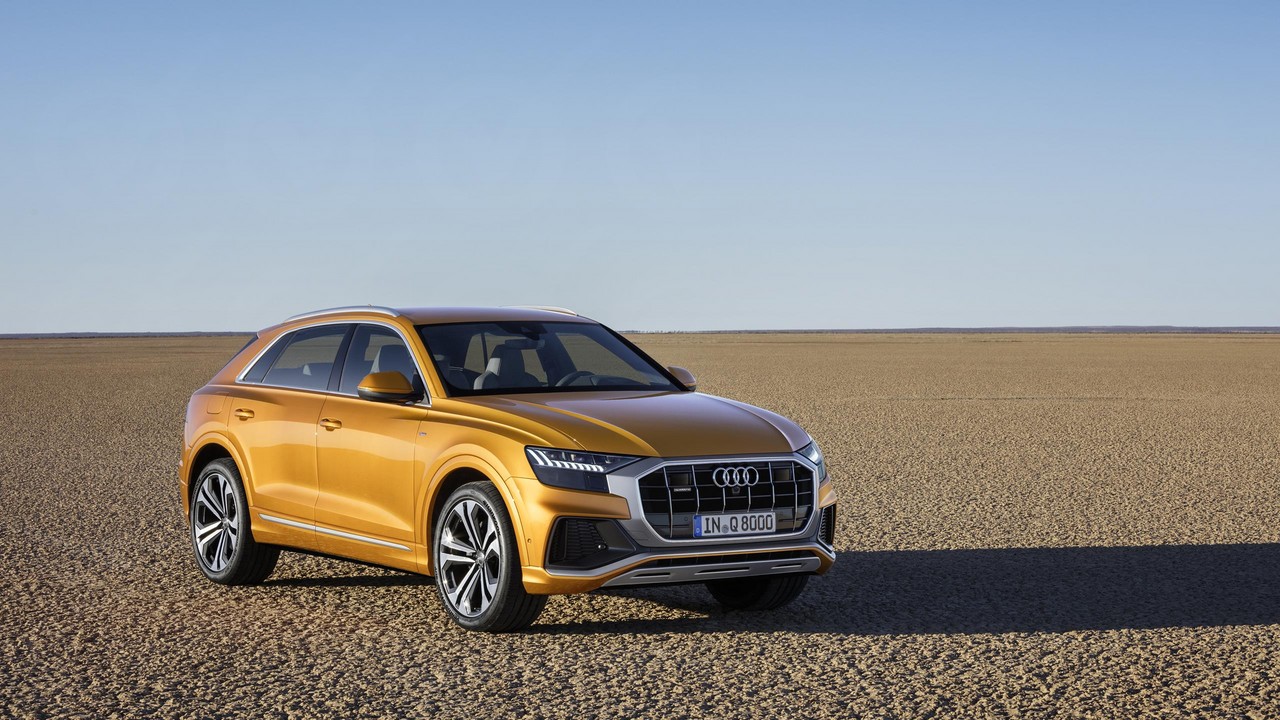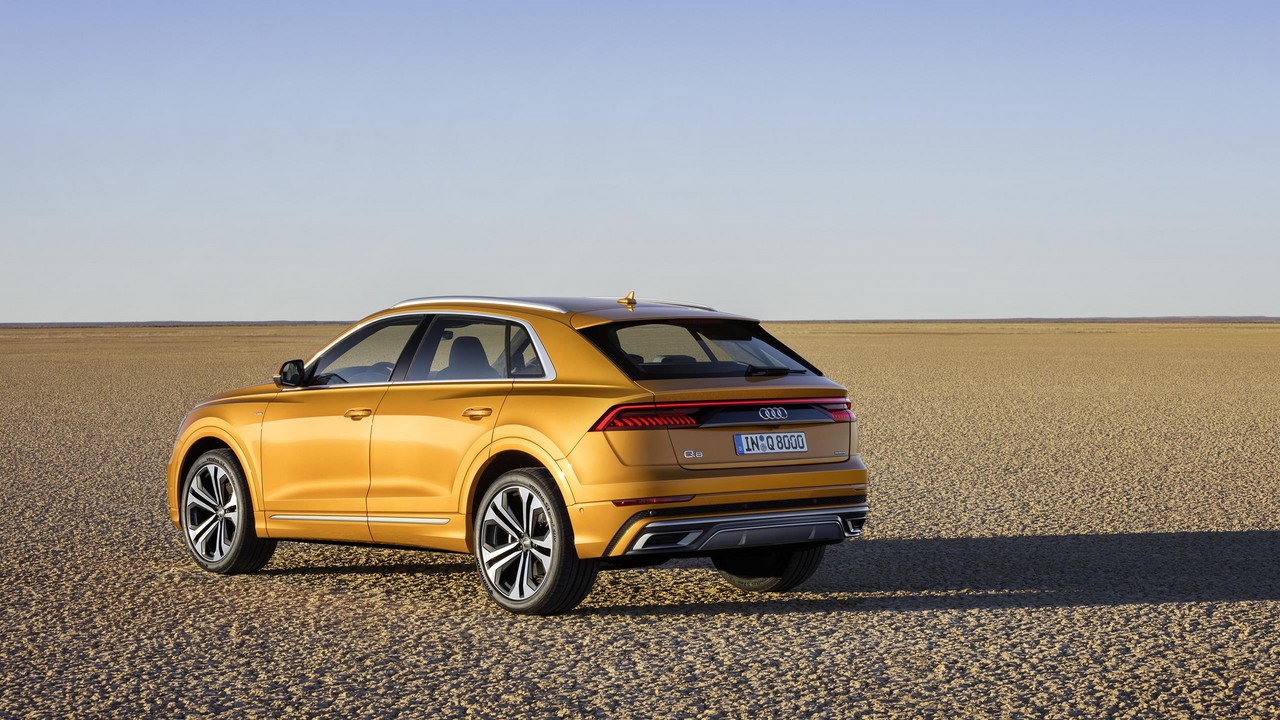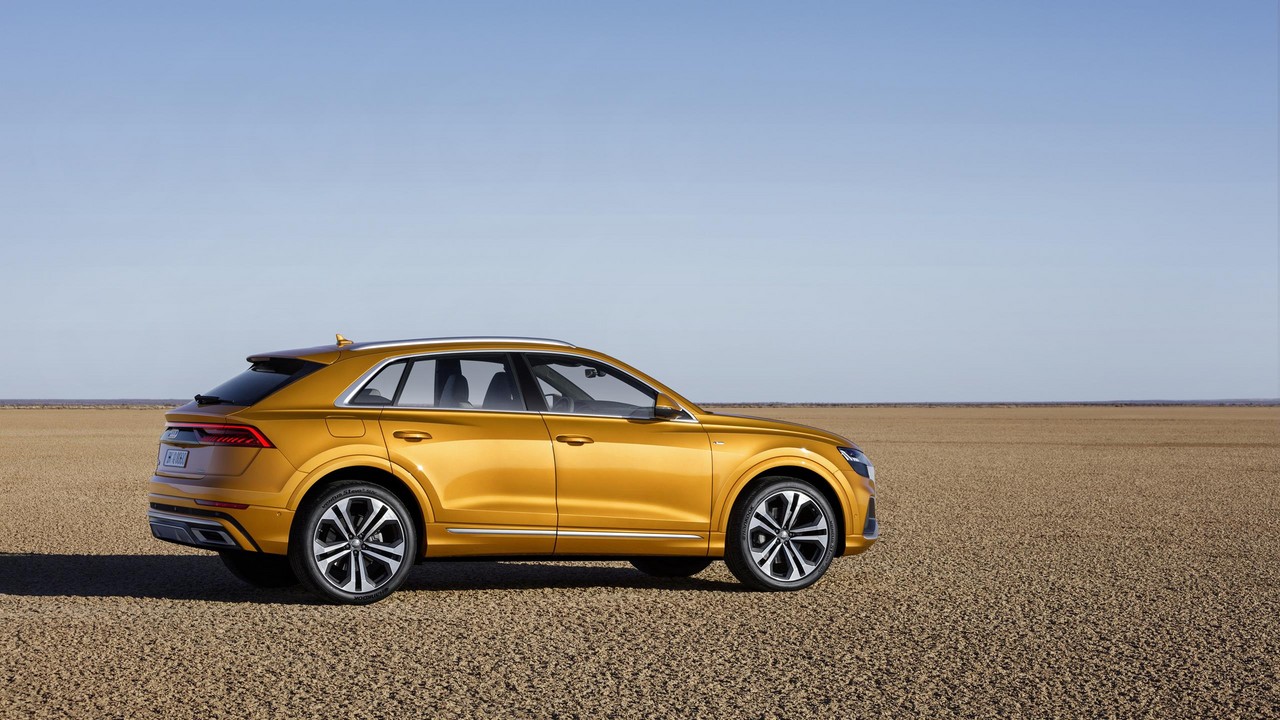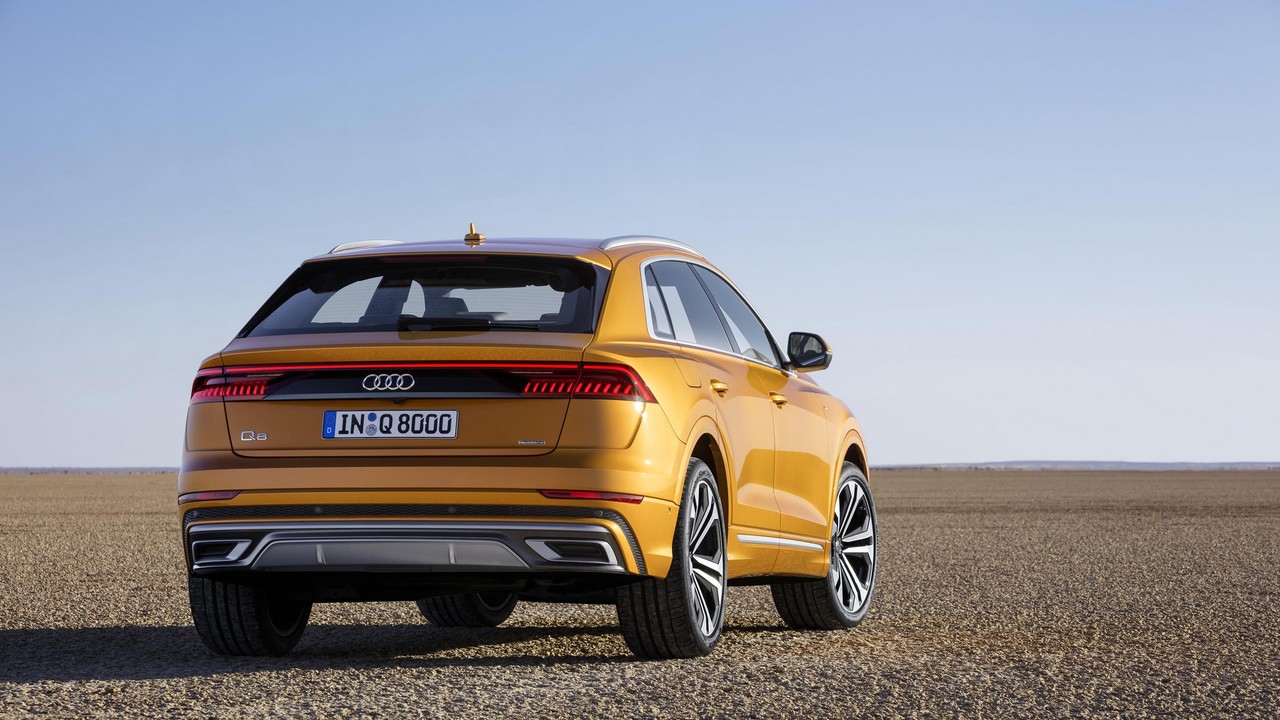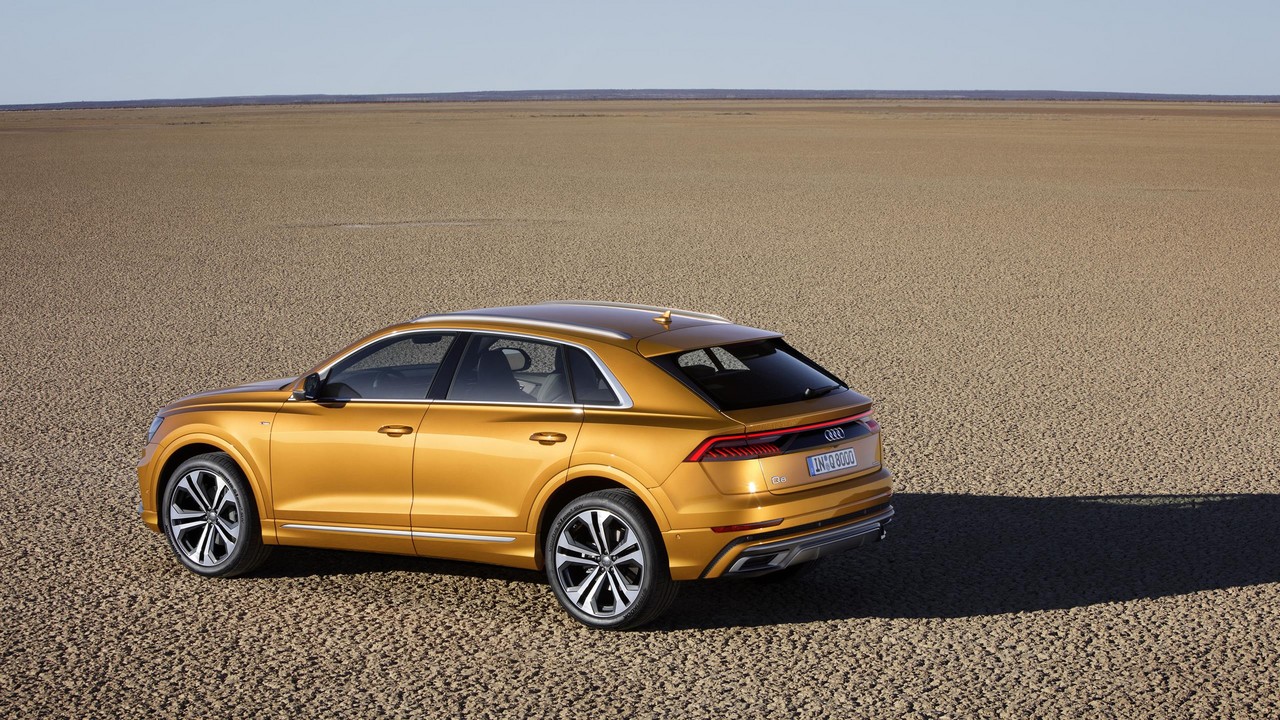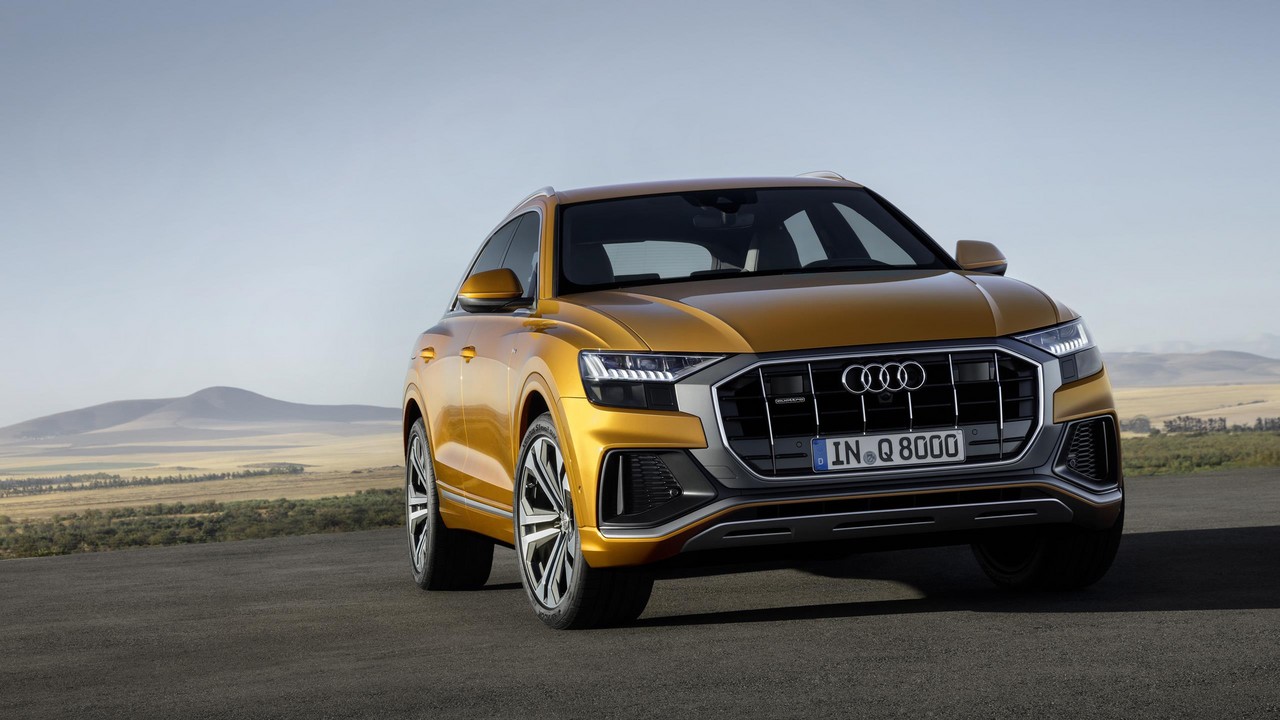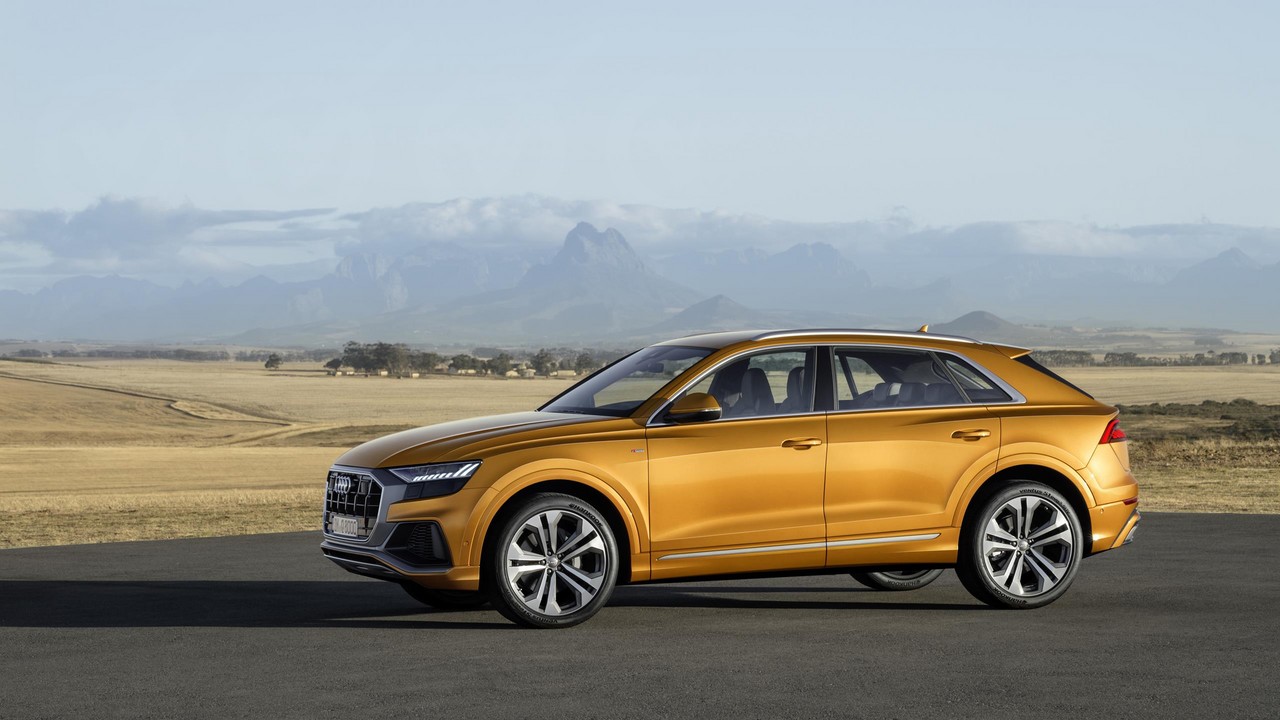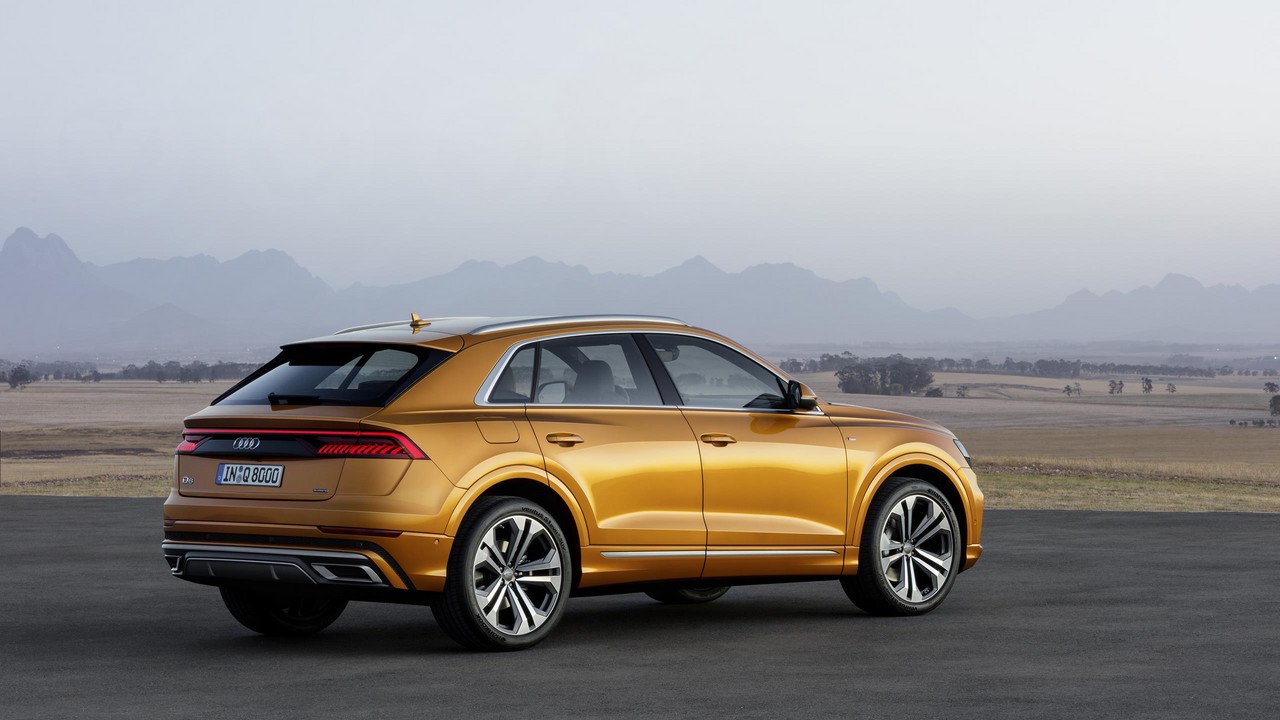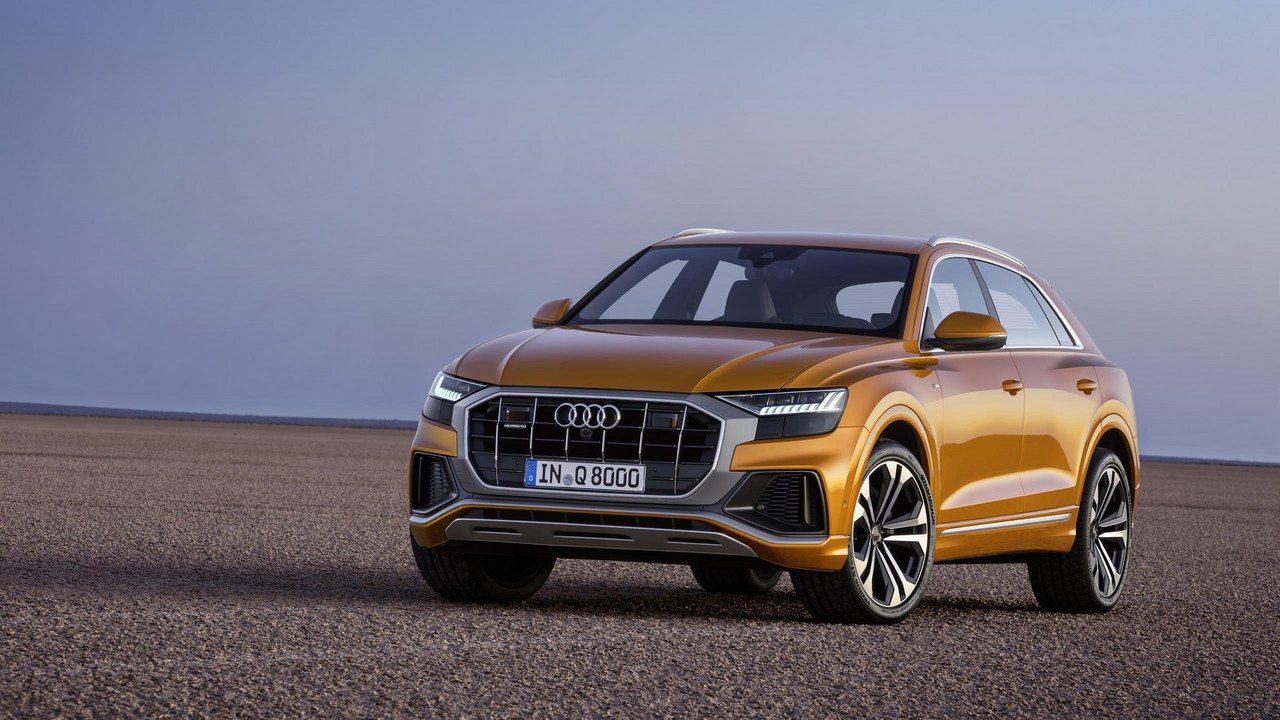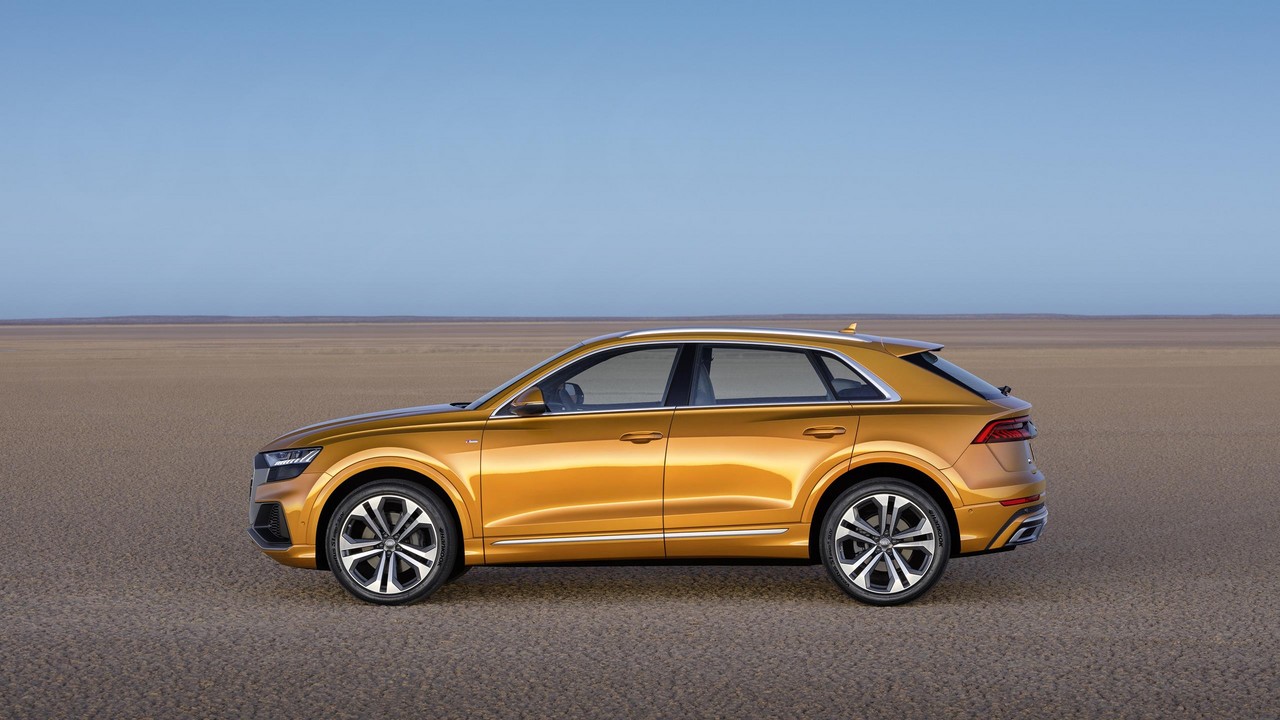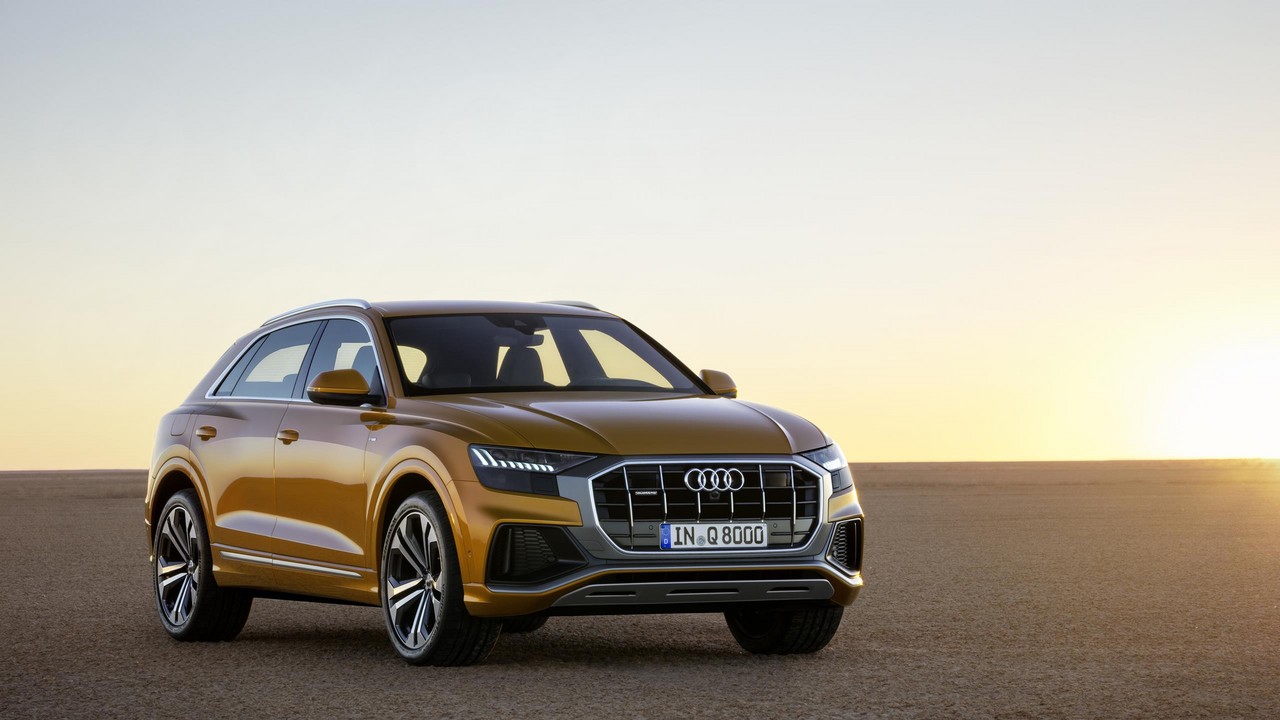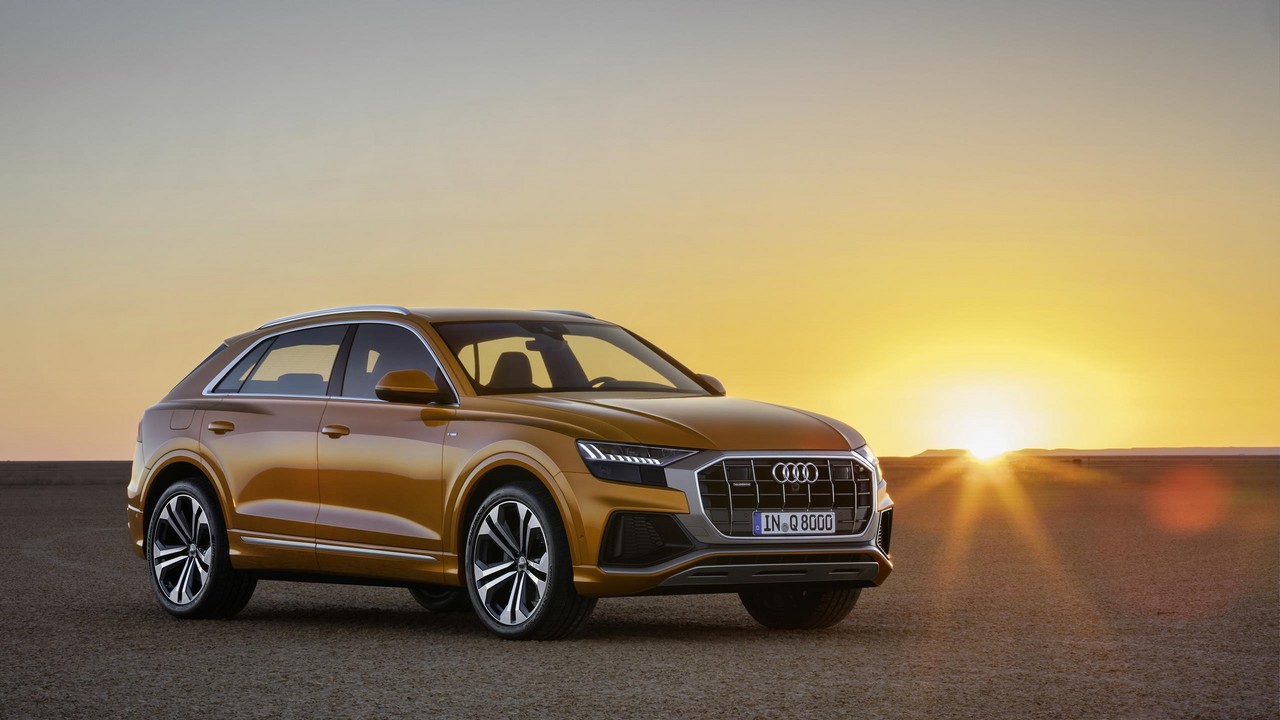
- Fuel-saving mild hybrid powertrains
- Array of active safety technologies
- Comfortable ride
- Competent dynamics
- High standard of interior fit and finish
- Quiet, well-insulated cabin…
- … though hurt by noise from optional 22-inch alloy wheels and low profile tyres
- Steering lacks feel and feedback
- For Q8 50 TDI, lack of torque below 1900 rpm
- Transmission slow to kick down
- Lacks the practicality of the Audi 4M Q7
Overview
Production of the Audi 4M Q8, an SUV with a coupe-like profile, commenced in July 2018 and Australian deliveries commenced in January 2019. Manufactured in Bratislava, Slovakia, the Audi Q8 is an all-wheel drive, five-seat SUV with a raked roofline. The Audi 4M Q8 was initially offered as a 55 TFSI variant, with 50 TDI variants following later in 2019. All variants, however, had a ‘mild hybrid’ system that consisted of a belt alternator starter (BAS) and a 10 Ah lithium-ion battery. As a result,
- The Audi Q8 could coast at speeds between 55 km/h and 160 km/h for up to 40 seconds. When the driver resumed acceleration, the BAS started the engine ‘quickly and smoothly’;
- When stationary, the engine would restart as soon as the vehicle ahead started moving;
- For models with V6 engines, a 48V main electrical system enabled the start-stop function to engage once vehicle speed fell below 22 km/h; and,
- During deceleration, the BAS could recover up to 12 kW of power which it stored in the lithium-ion battery.
| Variant | Engine | Trans. | Peak power | Peak torque |
|---|---|---|---|---|
| 55 TFSI | 2995 cc DCB turbo petrol V6 | 8sp auto | 250 kW at 5000-6400 rpm | 500 Nm at 1370-4500 rpm |
| 50 TDI | 2967 cc turbo diesel V6 | 8sp auto | 210 kW at 3800 rpm | 600 Nm at 2250-3250 rpm |
quattro all-wheel drive (AWD) system
The Audi Q8 had a mechanical all-wheel drive system which consisted of a self-locking central differential (designed as a planetary gear train). In normal conditions, the differential distributed 60 per cent of the engine’s torque to the rear axle and 40 per cent to the front, i.e. a 40:60 front:rear torque split. Depending on driving conditions, however, up to 70 per cent of the engine’s torque could be transferred to the front and up to 85 per cent to the rear.
Body and dimensions
The Audi Q8 was underpinned by Volkswagen Group’s MLBevo platform which was shared with the Audi 4M Q7 , Volkswagen Touareg III , Porsche PO536 Cayenne and Bentley Bentayga . For the body,
- Hot-shaped steel components – used in the lower section of the bulkhead, side sills, rear longitudinal members, B-pillars and the front zone of the roof frame – comprised 14.4 per cent of the body-in-white by mass;
- Aluminium castings – such as the strut mounts in the engine compartment and connecting points between the sills and longitudinal members – comprised 15.0 per cent; and,
- Aluminium sheeting – used for the side panels, large areas of the floor, the wheel housings, the roof, the frameless doors, front guards and rear hatch – comprised 23.7 per cent.
Three torsion rings reinforced the front end, the area of the C-pillars and the rear hatch cut-out. Furthermore, The Audi Q8 55 TFSI had an unladen weight of 2265 kg.
Compared to the Audi 4M Q7 , the Audi Q8 is 66 mm shorter (at 4986 mm), 27 mm wider (1995 mm), 36 mm lower (1705 mm) and has a 1 mm longer wheelbase (2995 mm); ground clearance is ‘up to’ 254 mm; its drag co-efficient was 0.34 Cd. Beyond this, ground clearance was 220 mm with the standard suspension, or 254 mm with the optional adaptive air suspension. The Audi Q8 had a luggage capacity of 605 litres, though this increased to 1755 litres when the rear seats were folded down.
Suspension
The Audi Q8 had five-link suspension front and rear. As standard, the suspension for the Audi Q8 featured electronically controlled dampers that varied damping according to road conditions and driver behaviour. To reduce mass, the links of the wheel suspensions were made from aluminium and high-strength steel, the cardan shafts of the front axle were hollow and the pivot bearings were aluminium forgings.
As an extra-cost option, the Audi Q8 was available with ‘adaptive air suspension’ (combined with electronically controlled damping). The air suspension could be adjusted through four modes via the Audi drive select system to vary ride height by up to 90 mm. At speeds below 30 km/h, the driver could increase ground clearance by up to 50 mm. As speed increased, the suspension automatically lowered the body in stages to reduce air resistance and improve dynamic capabilities. At speeds of 160 km/h and above, the vehicle was lowered by 40 mm compared to the standard level. When the vehicle was parked, the system could also lower the vehicle by 65 mm for easier loading and unloading.
Steering
The Audi Q8 had rack-and-pinion steering with speed-sensitive, electric power assistance and a progressive steering ratio (i.e. became more direct as steering angle increased) based on strain wave gearing.
As an extra-cost option, the Audi Q8 was available with all-wheel steering which used an electric spindle drive to turn the rear wheels inward by up to five degrees. At low speeds, the wheels turned in the opposite direction to the front wheels to reduce the vehicle’s turning circle. At high speeds, however, the rear wheels turned in the same direction as the front wheels by up to 1.5 degrees for greater stability.
Safety equipment
Standard safety equipment for the Audi Q8 included dual front airbags, front and rear seat-mounted airbags, full-length curtain airbags (i.e. for front and rear occupants), ABS, electronic brake force distribution, brake assist, electronic stability control, traction control and front seatbelts with pre-tensioners and load limiters.
For its active safety technologies, the Audi Q8 had twenty-four (24) scanners:
- A laser scanner – mounted in the front bumper – which emitted light pulses on several vertical planes and were distributed by a mirror over a field about 80 metres deep and through a range of 145 degrees. Since the wavelengths of the pulses were in the near infra-red range, they were not visible to the human eye. The pulses would be reflected by objects in front of the car, detected by photodiodes in the laser scanner and interpreted for a contoured image of the surroundings;
- A long-range front radar sensor;
- Four mid-range radar sensors at the corners of the vehicle;
- A front infra-red camera;
- A front camera at the top of the windscreen;
- Four cameras at the front, rear and door mirrors for 360 degree coverage; and,
- Twelve ultrasonic sensors at the front, flanks and rear.
All sensor data was processed by the central driver assistance controller (zFAS) to continuously compute a differentiated image of the surroundings. The zFAS controller was approximately the size of a tablet computer and integrated high-performance computers from NVIDIA (Tegra K1), ALTERA (Cyclon V), Infineon (Aurix) and the EyeQ3 image processor from Mobileye.
The Audi Q8 was fitted with the following active safety technologies as standard –
- Audi pre sense front: operated at speeds from 5 km/h to 85 km/h for pedestrian detection and up to 250 km/h for vehicle detection. In hazardous situations, Audi pre sense front would provide visual and acoustic warnings for the driver to apply the brakes, followed by a brief application of the brakes for a jolting effect to alert the driver. If the driver failed to respond, the Audi Q8 would decelerate to the greatest possible extent if the vehicle ahead of it was still moving;
- Audi pre sense rear: could warn of potential collisions from behind, alert following traffic by rapidly flashing the brake lights and activate the ‘pre sense basic’ protection measures described below;
- Pre sense basic: initiated occupant protection measures such as tightening the front seatbelts, closing the windows and sunroof (where fitted), and activating the hazard lights if ‘unstable driving conditions’ were detected or a collision was anticipated;
- Adaptive Cruise Assist (ACA): extended Adaptive Cruise Control (ACC) by adding a lane tracking function. ACA operated at speeds from rest to 250 km/h to keep the vehicle at the desired distance from the vehicle ahead and used ‘slight steering interventions’ to help the driver stay in their lane. ACA could be supplemented by ‘predictive control’ and ‘efficiency assist’ to enable an anticipatory driving style. To detect the traffic situation and course of the route, camera images and navigation were combined. If ACC was deactivated, ‘efficiency assist’ indicated to the driver when they should ease off the accelerator;
- Traffic jam assistant: as part of the ACC, the Traffic jam assistant provided automated steering if traffic was congested at speeds below 65 km/h;
- Bottleneck assist: where roadworks were being carried out, bottleneck assist would make steering corrections if the vehicle got too close to the edge of the road;
- Collision avoidance assist (also ‘Swerve Assist’): operating at speeds between 30 km/h and 150 km/h, collision avoidance assist was activated when the Audi Q8 needed to avoid an obstacle to avert a collision. Using data from the front camera, the ACC and radar sensors, the system could calculate the distance to the car ahead, its width and degree of offset. The brakes would be briefly applied to alert the driver of the potential danger and, once the driver started steering, the system would provide ‘support with the necessary lane changes with controlled interventions to the power steering’;
- Lane departure warning: active at speeds above 60 km/h, lane departure warning would warn the driver if they were about to cross lane markings and applied ‘corrective steering intervention’ to prevent the lane departure. The driver could also select a setting so that the steering wheel would vibrates as an additional warning;
- Audi side assist: operating at speeds above 15 km/h, Audi side assist used two rear radar sensors to monitor traffic up to 70 metres behind the vehicle. If another vehicle approached quickly or was in the driver’s blind spot, a warning LED in the housing of the appropriate door mirror would illuminate. If the driver activated the indicator to change lanes, LEDs would blink rapidly to warn the driver;
- Crossing assist front: if the mid-range radars at the vehicle’s corners – which had a range of approximately 75 metres – detected crossing traffic in front of the vehicle, the driver would be warned. Furthermore, the brakes would be applied if there was a collision risk;
- Turning assist (also ‘intersection crossing assist’): active at speeds from 2 km/h to 10 km/h, ‘turning assist’ operated once the driver activated the right-hand turn signal (for RHD vehicles) and could monitor oncoming traffic. In hazardous situations, the brakes could be applied to bring the vehicle to rest;
- Cross traffic assist rear: when reversing at low speeds, rear cross-traffic assist used the rear radar sensors to detect approaching traffic. If approaching traffic was detected which may cross the vehicle’s path, the driver would receive warnings (visual, acoustic and a brief, jolting application of the brakes);
- Exit warning: activated when the vehicle was stationary, exit warning would warn occupants if vehicles were approaching from behind by illuminating red fibre optics in the door-opening mechanism as the doors were opened;
- High beam assist: automatically switched between low and high beam headlights for improved visibility, using a sensor to determine when it was safe to do so (i.e. to avoid dazzling other drivers);
- Attention assist: monitored driver behaviour and issued a warning if the driver was assessed to be ‘inattentive’ or fatigued;
- Camera-based traffic sign recognition: used the camera to identify traffic signs and displays their contents to the driver as graphics in the head-up display and instrument cluster. The driver could also opt to receive visual warnings when they exceeded the speed limit that was indicated on traffic signs; and,
- Emergency assist: would bring the vehicle to rest if the driver was not able to do so.
Wheels, tyres and brakes
As standard, the Audi Q8 was fitted with 10.J x 21-inch alloy wheels and 255/40 R21 tyres. Furthermore, the Audi Q8 had 375 mm by 36 mm ventilated front brake discs with six-piston fixed callipers and 350 mm by 28 mm ventilated rear discs.
Features: Audi Q8
For Australian-delivered vehicles, the infotainment system for the Audi Q8 consisted of –
- MMI navigation plus: included a 10.1-inch central touchscreen and a lower 8.6-inch display for climate control and convenience functions;
- Audi sound system: a 180 watt system with ten speakers (including subwoofer), a six-channel amplifier and digital radio tuner (DAB+);
- Audi connect: data transfer module with the LTE Advanced standard and a Wi-Fi hotspot;
- Audi smartphone interface: connected Apple or Android devices via USB;
- Audi phone box light: wireless charging via the QI standard for compatible smartphones; and,
- Audi music interface: two USB interfaces with charging and data transfer functionality.
Beyond this, standard features for the Audi Q8 included power adjustable front seats with heating and ventilation functions, Valcona leather upholstery, three-zone climate control air conditioning, LED headlights, a leather steering wheel with gearshift paddles, remote central locking with proximity key, power adjustable and heated door mirrors with auto-dimming and folding functions, power windows, a height and reach adjustable steering wheel, an auto-dimming rear view mirror, memory settings (for the front seats and door mirrors), illuminated door sills, ambient interior lighting, tyre pressure monitoring, a trip computer, an alarm and immobiliser. As standard, the Audi Q8 was also fitted with:
- A head-up display (217 mm by 84 mm): projected vehicle speed and navigation instructions;
- A power-operated tailgate which could be opened or closed with a kicking motion beneath the rear bumper;
- ‘Audi parking system plus’ which included front and rear parking sensors and a rear view camera;
- A surround camera system which used four wide-angle cameras to generate a 360 degree view of the vehicle; and,
- Audi’s ‘virtual cockpit’, a configurable 12.3-inch colour display (1920 x 720 pixels) in place of conventional instrument cluster dials.
Options: Audi Q8
Extra-cost options for the Audi Q8 included –
- A Bang & Olufsen Advanced Sound System;
- Four-zone climate control air conditioning;
- Audi ‘HD Matrix’ LED headlights;
- Front contour seats with massage function;
- An ‘Audi connect key’ which enabled an Android smartphone to unlock, lock the car and start the engine using Near Field Communication (NFC). Furthermore, the owner can pass the access data to five smartphones; and,
- Remote garage pilot (from 2019): using the myAudi app on their smartphone, the remote garage pilot enabled the driver to remotely guide their vehicle into or out of a garage.
Specifications : Audi Q8
